Top Rankings
Nyack Union Free School District ranks among the top 20% of public school district in New York for:
Category
Attribute
Diversity
Most diverse schools (Top 1%)
Community Size
Largest student body (number of students) (Top 1%)
For the 2025 school year, there is 1 public middle school serving 648 students in Nyack Union Free School District. This district's average middle testing ranking is 7/10, which is in the top 50% of public middle schools in New York.
Public Middle School in Nyack Union Free School District have an average math proficiency score of 46% (versus the New York public middle school average of 40%), and reading proficiency score of 58% (versus the 51% statewide average).
Minority enrollment is 63% of the student body (majority Hispanic), which is equal to the New York public middle school average of 63% (majority Hispanic).
Overview
This School District
This State (NY)
# Schools
5 Schools
1,659 Schools
# Students
2,788 Students
890,054 Students
# Teachers
270 Teachers
83,739 Teachers
Student : Teacher Ratio
10:1
10:1
District Rank
Nyack Union Free School District, which is ranked #222 of all 1,015 school districts in New York (based off of combined math and reading proficiency testing data) for the 2021-2022 school year.
The school district's graduation rate of 92% has increased from 84% over five school years.
Overall District Rank
#215 out of 1020 school districts
(Top 30%)
(Top 30%)
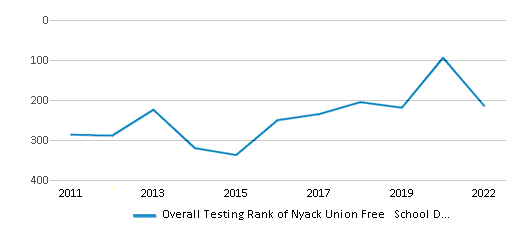
Math Test Scores (% Proficient)
59%
46%
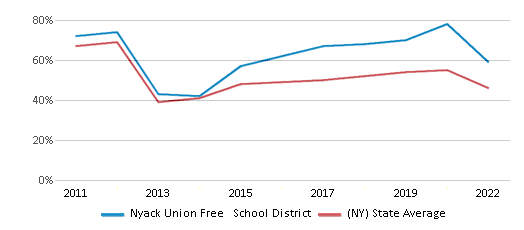
Reading/Language Arts Test Scores (% Proficient)
58%
49%

Science Test Scores (% Proficient)
85%
78%
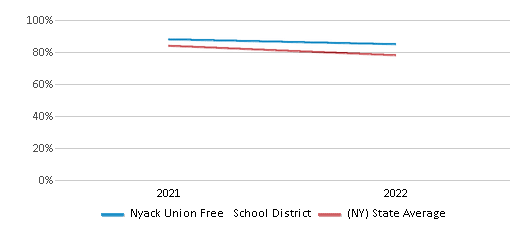
Graduation Rate
92%
87%
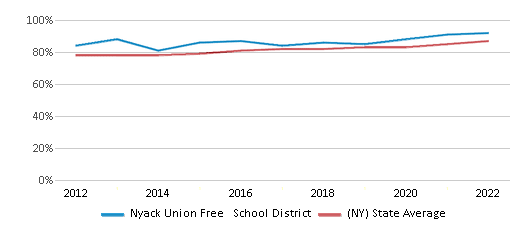
Students by Ethnicity:
Diversity Score
0.72
0.73
# American Indian Students
1 Student
7,222 Students
% American Indian Students
n/a
1%
# Asian Students
176 Students
81,213 Students
% Asian Students
6%
9%
# Hispanic Students
946 Students
270,400 Students
% Hispanic Students
34%
30%
# Black Students
393 Students
175,155 Students
% Black Students
14%
20%
# White Students
1,048 Students
325,608 Students
% White Students
38%
37%
# Hawaiian Students
16 Students
2,099 Students
% Hawaiian Students
1%
n/a
# Two or more races Students
205 Students
28,478 Students
% of Two or more races Students
7%
3%
Students by Grade:
# Students in PK Grade:
-
8,468
# Students in K Grade:
192
26,528
# Students in 1st Grade:
190
28,304
# Students in 2nd Grade:
199
28,365
# Students in 3rd Grade:
217
27,931
# Students in 4th Grade:
205
29,265
# Students in 5th Grade:
222
43,975
# Students in 6th Grade:
198
157,405
# Students in 7th Grade:
221
185,375
# Students in 8th Grade:
229
188,665
# Students in 9th Grade:
237
40,472
# Students in 10th Grade:
246
36,147
# Students in 11th Grade:
201
33,448
# Students in 12th Grade:
224
33,009
# Ungraded Students:
7
22,697
District Revenue and Spending
The revenue/student of $32,417 is higher than the state median of $31,307. The school district revenue/student has stayed relatively flat over four school years.
The school district's spending/student of $31,832 is less than the state median of $32,183. The school district spending/student has stayed relatively flat over four school years.
Total Revenue
$90 MM
$78,541 MM

Spending
$89 MM
$80,737 MM
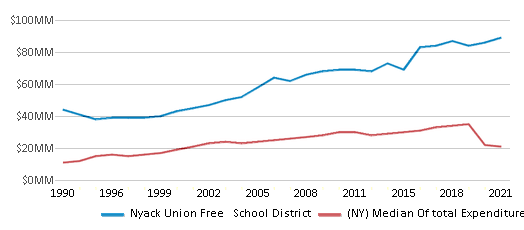
Revenue / Student
$32,417
$31,307
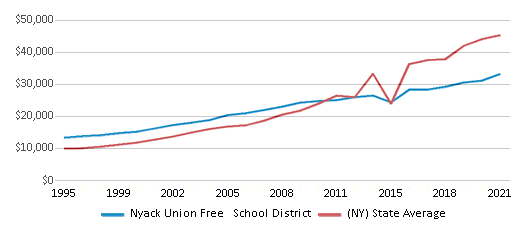
Spending / Student
$31,832
$32,183
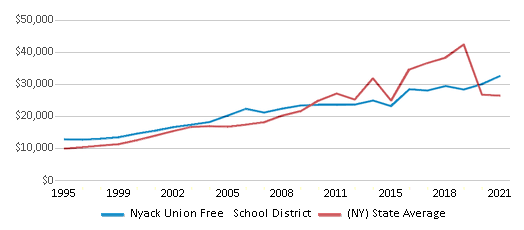
Best Nyack Union Free School District Public Middle Schools (2025)
School
(Math and Reading Proficiency)
(Math and Reading Proficiency)
Location
Grades
Students
Rank: #11.
Nyack Middle School
(Math: 46% | Reading: 58%)
Rank:
Rank:
7/
Top 50%10
98 S Highland Ave
Nyack, NY 10960
(845) 353-7200
Nyack, NY 10960
(845) 353-7200
Grades: 6-8
| 648 students
Recent Articles

Year-Round Or Traditional Schedule?
Which is more appropriate for your child? A year-round attendance schedule or traditional schedule? We look at the pros and cons.

Why You Should Encourage Your Child to Join a Sports Team
Participating in team sports has a great many benefits for children, there is no doubt. In this article you will learn what those benefits are.

White Students are Now the Minority in U.S. Public Schools
Increasing birth rates among immigrant families from Asia and Central and South America, combined with lower birth rates among white families, means that for the first time in history, public school students in the United States are majority-minority. This shift in demographics poses difficulties for schools as they work to accommodate children of varying language abilities and socio-economic backgrounds.





